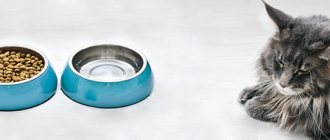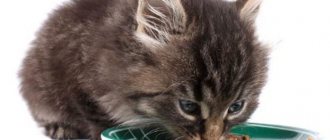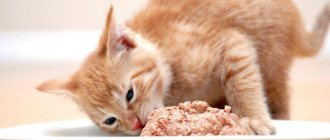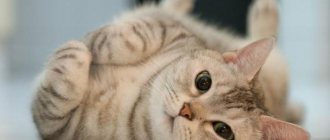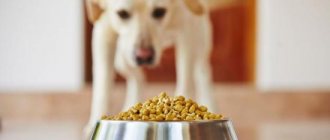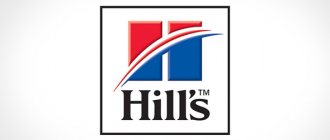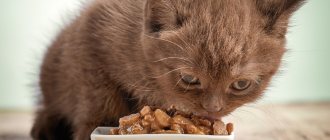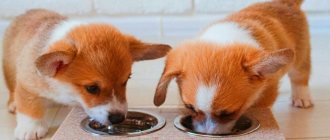Cats are very curious animals by nature. And it’s always interesting to try food from someone else’s bowl: what if the dog’s tastes better? But is it possible to feed a cat dog food? Will this harm her? Yes, a kitty may be interested in dog food because of the attractive smell. Or simply out of harm's way, eating dog food in front of the owner of the bowl. This is how some cats try to show who is boss. Unfortunately, dry and wet dog food is not suitable for feeding pet cats. But why? What is the difference between cat food and dog food?
Differences between dry cat and dog food
Despite the similarity in smell, granule shape, and consistency, cat and dog food are very different products. Differences in nutrition depend on the needs of the animals.
Pets
Set of ingredients and calorie content
The composition of dry food is selected taking into account the characteristics and nutritional needs of animals. They have different composition and balance of nutrients.
- cat food contains 2 times more protein, dog food contains fiber;
- feed contains different amounts of glucose;
- dog food is enriched with a large number of plant components;
- cat food contains taurine, an essential amino acid that plays an important role in the functioning of the cat’s body; taurine is not added to dog food;
- cat food contains more vitamin A;
- The acidity of cat food is higher than that of dog food;
- The energy value of dog food is slightly less than that of cat food.
Every pet should eat food that is suitable for it
The main danger of dry dog food is that it contains a large amount of grains and a small amount of meat. Excess grains in dog food can be dangerous for your cat.
The high cost of cat food is primarily due to the large proportion of meat in the composition. The amount of animal ingredients in cat food should be at least 70%. For dogs, an excess of proteins and fats is harmful to the liver and kidneys, so the basis of dog food is fiber, which can lead to serious health problems for the cat.
Cat foods are higher in calories than dog foods. This is due to the peculiarities of their diet: cats eat little, but often. Therefore, the food must contain enough nutrients to provide the body with energy.
BJU balance, acidity level
Dry food for cats and dogs has a different composition of proteins, fats and carbohydrates.
Protein is a building element of body cells. The necessary amino acids are formed from protein. Cats require 22 amino acids for normal body function. And he can synthesize only 12 of them independently.
The cat must receive a sufficient amount of protein, otherwise metabolic disorders may occur. Protein is essential for healthy growth, energy and proper functioning of the immune system. Protein is the main component of skin, hair, claws, ligaments and tendons.
For the average cat, protein standards are:
- growth stage – 30% protein of the total diet;
- adult cat – 20-25% protein of the entire diet;
- pregnancy and feeding – 35-40% protein of the entire diet.
If a cat has kidney problems, she is prescribed a diet with a reduced protein content. Treatment and diet are prescribed by a veterinarian.
Dog food lacks essential amino acids that are vital for cats. The most significant of them are taurine and arginine.
A cat's body cannot produce taurine on its own. This means that it must be supplied through food. The daily requirement of cats for taurine is 400 mg/kg, calculated based on the weight of the animal.
Taurine is found in specialized cat foods.
Taurine is mainly found in meat and seafood. Cats require taurine for vision, normal heart function and proper digestion. Taurine is necessary for cats for healthy conception and gestation of kittens; a deficiency leads to pathologies and miscarriages. Taurine supports the cat's immune system.
Taurine deficiency in a cat’s body primarily affects the deterioration of vision and heart function. It is impossible to determine on your own that the cause of poor health is a lack of taurine; this can only be determined by a veterinarian.
Taurine has been added to cat foods since the 1970s, so cats fed specialized foods do not have taurine deficiency.
There is no need to add taurine to dog food because dogs are able to synthesize this amino acid themselves in the liver. Feeding cats dog food will lead to taurine deficiency.
Arginine is another important amino acid. Due to a lack of arginine, the cat’s liver cannot fully utilize toxic substances, which can cause poisoning, even death.
Fats of animal origin contain linoleic and arachidonic acids, which are necessary for the normal life of cats. Linoleic acid is essential for strengthening the coat and skin. Without arachidonic acid, the normal functioning of the digestive, reproductive and other systems of the body is impossible. Unlike cats, dogs do not require arachidonic acid and it is not added to dog food.
Dogs get their carbohydrates from plant-based ingredients found in their food. For cats, the amount of such carbohydrates is excessive, which can provoke obesity and the development of diabetes.
Dog and cat food have different ratios of proteins, fats and carbohydrates
The acidity level in cat foods is higher than in dog foods, which helps prevent the occurrence of urolithiasis. This is especially true for sterilized cats and neutered cats. If dogs do not have health problems, they do not need to adjust their pH levels.
Nutrients and granule size
Due to differences in their natural diets, dogs and cats have different daily nutrient requirements.
Dog food, like cat food, contains vitamins A, B, C, E and others. But dog food for cats lacks iodine and biotin, as well as vitamins B and E. And the content of vitamins A, C, D, K exceeds the amount a cat needs. There is also more calcium and magnesium in dog food than a cat needs.
Cats need B vitamins more than dogs. Therefore, if they are deficient, they may experience increased fatigue and irritability. The cat sleeps poorly and suffers from mood swings.
While eating, dogs tear off pieces of meat, chew them and swallow them. Due to the structure of their jaw, cats are better at separating muscle tissue, but practically do not grind food. For this reason, cat food manufacturers try to make the granules small so that the animal only needs to bite a piece. Cats should not be given dog food because chewing dog food can lead to thinning of the protective layer of the teeth and loss of fangs.
Fats and carbohydrates: necessary and unnecessary
The content of animal fats, extremely important sources of essential Omega-3 fatty acids necessary for the absorption of fat-soluble vitamins and maintaining thermoregulation, should also be somewhat higher in cat food.
In addition, fats in the diet of dogs and cats serve as the main source of energy, that is, they play the same role in their bodies as carbohydrates do in the diet of humans. But regarding the latter, the truth is that neither cats nor dogs need them at all, and their amount in the food should be minimal. Moreover, while dogs, over thousands of years of dependence on humans for food, have managed to acquire some kind of adaptive enzyme mechanism that allows them to absorb a certain amount of carbohydrates, cats do not have it.
In fact, all the carbohydrates that they receive from food either come out partially undigested (if these are so-called complex carbohydrates, for example, legumes) - and this is the best option, or are immediately stored in fat (fast carbohydrates - grains), which is much worse , as it leads to obesity with all its serious health consequences.
This is why cat food always contains fewer carbohydrates than dog food, but in many diets the amount is still too high. And this is another reason to choose Acana and Orijen low-carbohydrate biologically appropriate foods for both cats and dogs.
What is the difference between wet cat food and dog food?
Wet food also differs in composition. Wet food for dogs, similar to dry food, contains fewer micro- and macroelements to maintain normal metabolism in a cat. Therefore, the answer to the question of whether cats can be given wet dog food is the same. You should not feed cats liquid dog food for a long time, as this can lead to digestive disorders.
Wet dog food is just as dangerous to cats as dry food when fed daily.
Sometimes you can give your cat premium quality canned dog food that contains only meat and broth. They differ little in composition from cat food. But it is not recommended to feed cats such canned food every day.
Differences in nutritional needs of dogs and cats
Both animals belong to the order of predators, but during their time living near humans, the digestion of dogs has changed more than that of cats. They learned to obtain part of the protein and micronutrients from plant products, and to synthesize amino acids and vitamins themselves. In extreme situations they survive without meat.
Cats became indoor animals relatively recently, so their digestion remains the same as that of their wild relatives. Nutrients are taken from animal products, plant foods are absorbed by 10%. Cats, unlike dogs, do not synthesize a number of amino acids and receive them only from food.
These include:
- Taurine is concentrated in muscles, nerve fibers, supports the heart, and the retina. It is not found in plants and does not accumulate in the body, so cats need to receive this amino acid daily from animal food.
- Vitamin A is responsible for cell growth, immunity, and affects visual acuity. Cats absorb it from meat foods, but cannot synthesize beta-carotene into retinol from plant foods.
- Arginine is an amino acid that is part of protein. It is involved in the removal from the body of toxic ammonia compounds that are formed after the breakdown of proteins. Cats get arginine from meat products.
- Vitamin PP affects the metabolism of proteins and carbohydrates, oxidation and reduction processes, the synthesis of a number of hormones, and supports mucous membranes. Cats need it more than dogs.
- Arachidonic acid regulates cell renewal, blood clotting, and affects the functioning of the reproductive organs, stomach, and intestines. Cats get it from animal fats.
- Linoleic and linolenic acids participate in metabolic processes, inhibit the development of inflammation, strengthen hair and skin.
These components are added to cat food, but they are not enough for cats in dog food.
Why does a cat eat dog food?
There are several reasons why cats may be attracted to dog food:
- Curiosity. Cats are very curious. They try and try to eat any object that seems suitable for this.
- Dominance. Sometimes cats eat from a dog's bowl to show their leadership.
- The smell of certain ingredients. Your cat may be attracted to the aroma of meat, especially in canned dog meats.
- Feed texture. Perhaps the cat likes to feel this type of food on his tongue.
- Features of the structure of a cat's face. For example, cats with a short muzzle (Persian) may have difficulty getting pieces of food out of their bowl, while dog food is more convenient in this regard.
Observe your cat to understand the reasons for eating dog food. If this happens rarely, the cat may just be curious. If your pet constantly eats from the dog's bowl and refuses its food, it is necessary to check the cat's health. Perhaps she has abnormalities in her body.
What can happen to a cat if it eats dog food?
The nutritional needs of cats and dogs differ due to the physiological characteristics of the animals' organisms. If you feed your cat dog food, after a while it will become severely nutrient deficient.
Dogs and cats have different nutritional needs
As a treat
Nothing bad will happen if your cat eats a few pieces of dog food once. But if you feed your cat a little every day, giving her dog food as a treat, this will lead to an imbalance of micro- and macroelements in the diet. In this capacity, it is better to give the cat a special cat treat or soft food.
There are foods that are suitable for both dogs and cats. Most often these are medicinal products for rehabilitation after surgery or illness. They are given to animals only when strictly necessary and prescribed by a veterinarian.
During a long time
What happens if you regularly feed a cat dog food? Eating unsuitable food for a long time can cause deterioration in health. If your cat eats dog food frequently, the following problems may occur:
- Dental problems. Cat enamel is more delicate than dog enamel, and large granules are more difficult to chew. This leads to a thinning of the protective layer and subsequent loss of fangs.
- Skin problems. The skin becomes dry and flaky due to a lack of vitamins and amino acids. Dandruff may appear on the fur.
- Deterioration in wool quality. The coat becomes dull and sparse. This is due to a deficiency of nutrients. Your pet may shed year-round.
- Deterioration of vision. Due to taurine deficiency, problems with the retina are possible, and kittens may experience blindness.
- General exhaustion. A lack of amino acids and fats leads to lethargy and apathy of the pet. The cat reacts worse to what is happening and spends more time sleeping.
- Diabetes. Occurs due to an excess of grains in the diet. They contain too many fast carbohydrates.
- Obesity. Some of the carbohydrates contained in dog food are transferred into the cat's fatty tissue. Excess weight leads to serious health problems. It increases the load on the musculoskeletal system, and internal organs receive less nutrients.
- Pancreatitis. Excess carbohydrates increase the load on the pancreas. The result is inflammation, which can become chronic.
- Urolithiasis disease. Develops due to an excess of vitamin C and magnesium.
- Allergy. Cereals often cause allergic reactions in cats, which may include itching, sneezing, watery eyes, skin irritation, etc.
- If a cat eats dog food for a long time, it may get used to it and refuse other food. In this case, you will have to wean your pet off the wrong diet.
Can cats eat dog food? The answer is clear!
Thus, as you understand, dog food is completely unsuitable for feeding cats, and it is impossible to give it to these animals on an ongoing basis, since the consequences of such a diet can be very serious. But we would like to note that it is equally important to choose high-quality food for your pets with a high content of meat ingredients, because even enrichment with synthesized vitamins and amino acids will not replace fresh sources of animal protein, which is an absolutely necessary component of daily nutrition for cats.
How to wean your cat off its addiction to dog food
Having noticed that the cat refuses the food offered to it and prefers food from the dog bowl, the owner should take action. The animal may not understand that dog food is harmful to its health and does not meet all the body's needs. The owner’s task is to reorient the cat towards healthy food designed specifically for it.
Feed your pets in different rooms
in different rooms, so the cat will be less tempted. 10-15 minutes after feeding the dog, you need to remove the remaining food from the bowl and wash it thoroughly.
If the dog is a large breed, then you can purchase a special stand for it, on which the bowl will be located just below the level of its mouth; for a cat, such a height will be inaccessible.
Food for both cats and dogs should be stored out of reach, in packaging that cannot be chewed.
Owners should reconsider their cat's diet. The reason that she eats the dog's food may be that she is not satisfied with her own food. You need to try offering her other brands of food, both dry and wet.
Feed differences
Dog food differs from cat food in the ratio of proteins, fats and carbohydrates:
- Contains fewer meat ingredients and no eggs are added. Cats do not receive the required amount of taurine and arginine. With a regular lack of proteins, liver enzymes break down their own proteins.
- Includes more grains, vegetables . The cat's intestines are a third shorter and do not absorb them completely. The amylase enzyme is responsible for the breakdown of starch and plant components; cats produce only 5% of this figure in dogs.
- Contains less fat . Cats develop a deficiency of arachidonic acid and do not absorb fat-soluble vitamins.
Dog kibble for cats lacks vitamins B, E, iodine, and biotin. The content of individual micronutrients exceeds the norm for cats: calcium, magnesium, vitamins C, A, D, K. Dogs synthesize taurine themselves, so it is not added to food.
How to Prevent Stealing from Your Dog Bowl
It is almost impossible to wean a cat from stealing from a dog bowl through education and training, so you can use alternative methods.
Tastes better from a friend's bowl
You can make sound traps from cans, nuts or cereals. When your pet approaches the dog's bowl, scare him with noise each time. But this method has a number of disadvantages.
First, the cat owner must be patient and consistent. The cat will try again and again to get to the dog food.
Secondly, if a pet steals someone else’s food at least once, progress can be considered lost.
Thirdly, the traps will have to be set so that they are triggered when the owner is sleeping or no one is home. Otherwise, the cat will only steal at night or in the absence of people.
The main disadvantage is the possibility of psychological disorders. Noise, water and other punishments can cause a cat to become nervous. If the animal has a weak heart, complications may arise.
A cat will not steal dog food if it is sure that it will always be fed on time. Feed your pet a thoughtful diet of complete ingredients.
Consequences
If cats are regularly fed dog food, they may develop health problems:
- With a lack of protein, muscle mass is lost and replaced by fat.
- Excess carbohydrates overload the pancreas, leading to excess weight gain.
- A lack of taurine affects eye health, retinal atrophy occurs, vision decreases, and digestion is upset. Over time, the heart muscle weakens and cardiomyopathy develops.
- With a lack of arginine, symptoms of ammonia poisoning appear: lethargy, nausea, drooling, convulsions.
- A deficiency of unsaturated fatty acids provokes skin problems: the structure of the skin is disrupted, dandruff appears, the coat loses its shine, and falls out. The animal often catches colds and suffers from indigestion.
- With hypervitaminosis D, calcium metabolism is disrupted and it is deposited in soft tissues.
- Excess ascorbic acid increases the acidity of urine and precipitates in the form of crystals.
- Excess retinol affects the musculoskeletal system and joint mobility.
- Tocopherol deficiency leads to decreased immunity and reproductive functions.
- Against the background of a lack of nicotinic acid (PP), metabolism and digestion are disrupted, and dermatitis develops.
- With excess calcium, bone tissue grows and kidney problems begin.
- Excess magnesium provokes urolithiasis.
The composition of dog food is not suitable for cats, so pets are given food at different times, each is given a place, and no food is left out. If the cat continues to reach for the dog bowl, try changing the brand of food. Accidentally eating pellets will not affect the cat’s health; intentional feeding involves a trip to the veterinary clinic.
Why owners choose dog food to feed cats
Dog food of the same brand as cat food is often cheaper. Most stores offer regular promotions and discounts on dog food. But the money saved will have to be spent on veterinarian services soon.
Dry dog food is usually purchased in large packs and is always on hand. But you can also buy cat food in large packages of 10-15 kg, which will last for a long time.
If the owner sees that the cat eats dog food with pleasure, there may be a feeling that the cat prefers this particular type of food. Therefore, the owners decide that there is nothing wrong with such feeding.
General recommendations for feeding cats with industrial food
All industrial feeds have advantages and disadvantages. The first usually outweighs the second due to lack of time from the owners. An alternative to food is a natural diet, that is, regularly preparing food for your pet.
Industrial cat food is divided into classes and types:
- Economy, premium (everyday), super-premium, holistic.
- Wet, semi-moist, dry food.
Super-premium and higher class cat food contains all the important nutrients, vitamins and microelements. In this case, the owner can feed the cat dry food, alternating with semi-moist or wet food (of the same brand and line).
Economy and premium classes are not fully fortified and may contain preservatives. At the same time, premium food is considered everyday food, that is, suitable for regular feeding of healthy animals. Economy class is a dangerous line, produced with the expectation of illiterate owners. Vivid advertising and a relatively attractive price play a significant role. Trying to do the best, owners literally sacrifice the health of their pets... although if the owner reads the ingredients of the product, then the risk is quite conscious.
The modern range of food allows you to choose a balanced diet for any, even the most picky pet. At the very least, the cat will definitely not refuse to eat wet food or pates. Some difficulties may arise with the selection of dry food, since it is not so fragrant.
